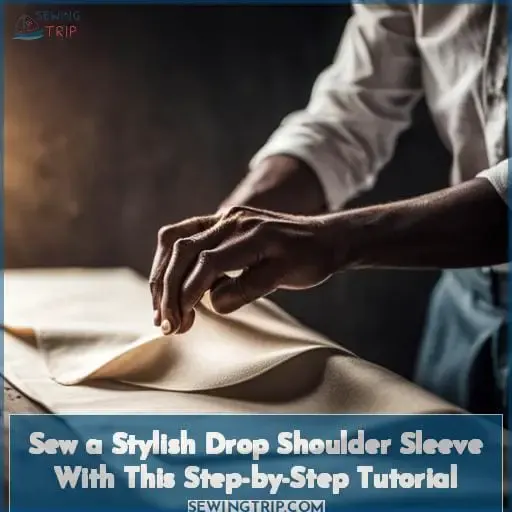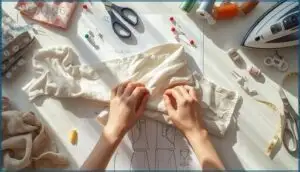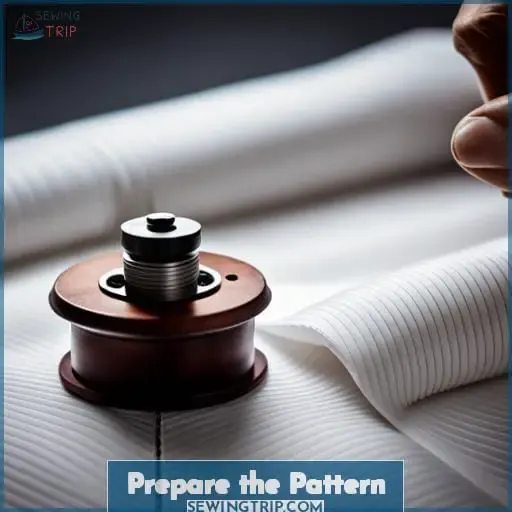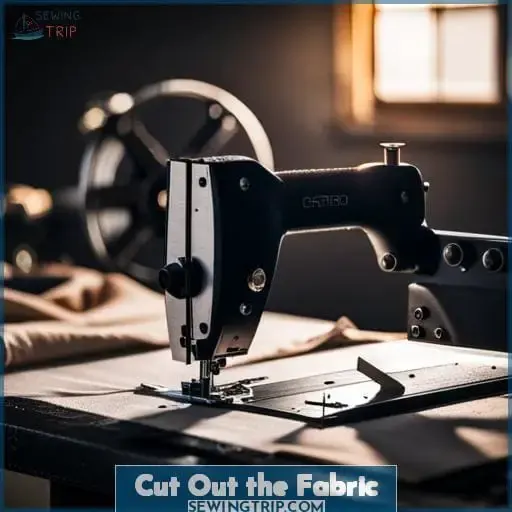This site is supported by our readers. We may earn a commission, at no cost to you, if you purchase through links.

Follow this comprehensive guide as we delve into the nuances of constructing a drop shoulder sleeve, from preparing the pattern to attaching it to the bodice.
Learn how to create a garment that’s both stylish and well-crafted, giving you the confidence to elevate your sewing skills to the next level.
Table Of Contents
Key Takeaways
- Choose knit fabrics with good stretch and recovery like lightweight jersey or interlock knits
- Enlarge the sleeve head and lower the shoulder seam when adjusting the pattern
- Allow ease in the sleeve cap and use a medium stitch length when constructing
- Create clean finishes on edges with techniques like hemming or binding
Materials Needed
You’ll need fabric, a sleeve pattern adjusted for the drop shoulder, and all your usual sewing tools to construct the drop shoulder sleeve.
Gather fabric, thread, sewing machine, scissors, tape measure, chalk, pins, and iron before beginning.
With the right materials prepped, you’ll be ready to sew up a stylish drop shoulder sleeve.
Fabric
You’ll need fabric with enough stretch and drape for the drop shoulder design.
Choose from these 4 fabric options:
- Lightweight jersey knits
- Medium-weight interlock knits
- Sweatshirt fleece
- Lightweight woven fabrics
Pattern
To prepare the drop shoulder sleeve pattern:
Trace an existing set-in sleeve pattern and lower the shoulder seam line by 1-2 inches.
Widen the sleeve cap curve to create extra ease.
Cut out both bodice and modified sleeve pieces from your fabric, ready for assembly.
Sewing Tools
You often also need sewing tools like scissors, sewing machines, and needles to make a drop shoulder sleeve garment.
Select quality shears, sharp needles, and a heavy-duty machine for handling thicker fabrics when constructing drop sleeves.
Invest in high-performing equipment for flawless finishing and professional results.
Prepare the Pattern
Now that your materials are gathered, it’s time to prepare the pattern.
Trace or draft the drop shoulder sleeve pieces.
Carefully cut out the bodice and sleeve patterns.
You’ll need these to cut out your fabric pieces in the next steps.
Trace or Draft Drop Shoulder Sleeve
You can trace or draft a new drop shoulder sleeve pattern by enlarging the existing sleeve head and lowering the shoulder seam line.
- Measure across the existing sleeve head and add 1-2 inches.
- Draw a new shoulder line 1-2 inches below the original.
- Cut along the new shoulder line to create the drop sleeve pattern piece.
Cut Out Bodice and Sleeve Pieces
After tracing or drafting the new drop shoulder sleeve pattern pieces, cut out the bodice and sleeve pieces from the altered pattern.
Bodice Piece
Front
Back
Side Front
Side Back
Carefully cut out each piece following the new pattern lines. Take your time to ensure smooth edges for easy sewing.
Now the fun construction begins!
Cut Out the Fabric
Once your pattern pieces are prepared, carefully cut out your fabric using the altered bodice and sleeve patterns.
Lay out the fabric wrong side up and pin the pattern pieces in place, ensuring there’s enough fabric to accommodate each piece with adequate seam allowances.
Use sharp fabric scissors to precisely cut around each piece. Take care not to stretch or distort the fabric as you cut.
Mark any pattern markings, like darts or gathering lines, onto the fabric pieces with tailor’s chalk.
For knit fabrics, consider using weights or spray adhesive to prevent the fabric from shifting during cutting.
Cut neat and accurate pieces, transferring all pattern markings, for ease of construction later.
With your fabric pieces cut, you’re ready to move on to sewing your stylish drop-shoulder sleeved garment.
Construct the Garment
Let’s move on to constructing the garment.
Start by sewing the shoulder seams of the front and back bodice pieces together.
Then, attach the sleeves to the bodice, matching the shoulder seams.
Sew Shoulder Seams
Carrying on from cutting out the fabric pieces, stitch the shoulder seams together to construct the garment.
Join the front and back bodice at the shoulders using your sewing machine.
Focus on neatening the seam allowances and easing any fullness for a smooth fit.
Allowing extra width at the armholes gives freedom of movement.
Creative dropped shoulders invite playing with unconventional shapes for personalized style.
Drapey fabrics show off the relaxed silhouette.
Attach Sleeves to Bodice
Now you can attach the sleeves to the bodice, matching the shoulder seams.
Pin the sleeve heads to the armholes and ease any excess fullness.
Sew the sleeves in place using a narrow zigzag or stretch stitch to allow movement.
For a modern style, try a contrasting sleeve in a fun print, pleated fabric, or knit.
Finish by serging or binding the raw edges for a professional look.
Finish the Sleeve Edges
Having attached the sleeves to the bodice, finish the sleeve edges by hemming or binding them.
For a clean finish, turn under the raw edge 1/4 inch and topstitch close to the folded edge.
For a decorative touch, use a contrasting binding sewn to the raw edge. Fold the binding over the edge to encase it.
Get creative with embellishments like lace, ruffles, decorative stitches, or trims sewn along the hem.
This adds polish to your sleeves and prevents raveling.
Take time perfecting the details – it elevates the overall look.
Finishing touches like hemming show your skill and care creating garments.
Frequently Asked Questions (FAQs)
What fabric type is best to use for a drop shoulder sleeve?
For drop shoulders, use a knit fabric with good stretch and recovery.
This allows ease of movement and maintains the drape around the upper arm.
Choose stable knits that won’t lose their shape, like interlock or sweatshirt fleece.
Stay away from lightweight, clingy knits without enough structure.
How much ease should be added to the sleeve cap when drafting a drop shoulder sleeve pattern?
When drafting a drop shoulder sleeve pattern, allow at least 2 inches of ease around the sleeve cap.
This extra room enables the fabric to drape smoothly over the shoulder without pulling or restricting arm movement.
What stitch length should be used when constructing the garment?
Use a medium stitch length, around 5 mm, when constructing the drop shoulder sleeve garment.
Backstitch at the start and end.
How can the neckline be finished neatly?
When sewing knits, a simple turned and stitched neckband creates a clean finish.
Fold under 1/4-inch and edge-stitch; the band stretches with the neckline, preventing any gapping.
This quick neck treatment maintains the garment’s soft drape.
What type of hem finishes work best for a knit drop shoulder sleeve tee?
For a polished finish, consider hemming your knit drop-shoulder sleeve tee with a double-fold hem.
Utilize a coverstitch machine or a twin needle on your sewing machine for a professional touch.
Conclusion
With precision and care, you’ve sewn a drop shoulder sleeve.
It accentuates your figure while allowing full range of motion.
Revel in this crowning moment, having honed your skills through diligent practice.
Though the journey brought challenges, take pride in your mastery of intricate techniques.
Wear your creation with grace, a vision in comfort and style.
Sewing is an art – let your garment express your creative spirit.











